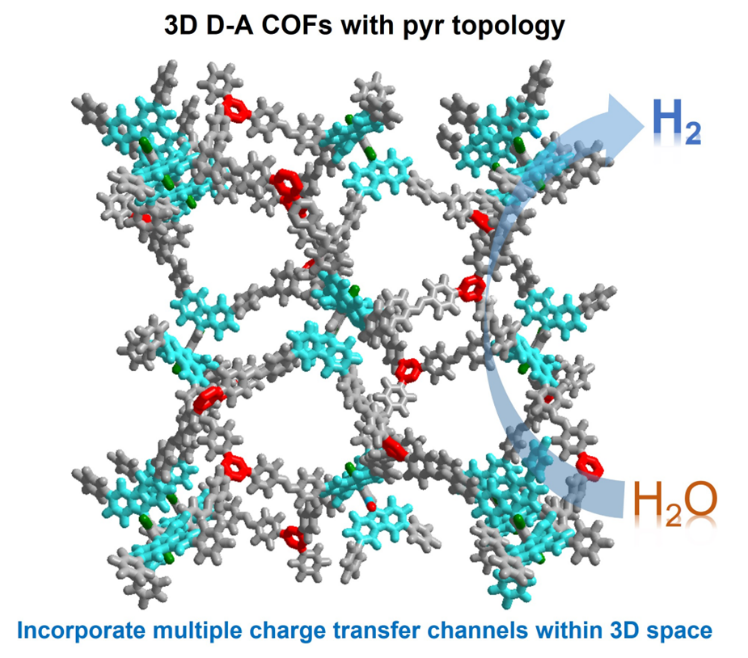Covalent organic frameworks (COFs) represent a class of well-defined crystalline organic materials distinguished by their predictable and highly ordered lattice structures. This structural precision renders COFs particularly promising as photocatalysts, with significant advancements being achieved over the past decade. However, their widespread photocatalytic application faces a critical challenge due to inefficient charge carrier separation. The construction of donor-acceptor (D-A) type conjugated COFs has emerged as an effective strategy to enhance photocatalytic performance.
Extensive research has focused on two-dimensional (2D) conjugated D-A COFs for photocatalytic applications, investigations into three-dimensional (3D) conjugated frameworks remain relatively scarce. In 2D COFs, van der Waals interactions (particularly π-π stacking) perpendicular to the molecular planes hinder interlayer charge carrier migration. In contrast, 3D COFs overcome these interlayer transport limitations while offering additional advantages, including larger active surface areas, more extensive charge transport pathways, and richer pore structures, making them potentially superior to their 2D counterparts for photocatalytic applications.
In a study published in Angewandte Chemie International Edition, Prof. YUANDaqiang and Prof. LIN Shaoxia, along with their research team at the Fujian Institute of Research on the Structure of Matter, Chinese Academy of Sciences, developed three distinct 3D extended D-A COFs with a pyr topology by employing a newly designed intrinsic D-A type building block.
By strategically selecting TAPA, TAPB, and TAPT as donor, acceptor-π, and acceptor-donor components respectively, the researchers synthesized three distinct D-A extended covalent organic framework materials: D-D-A, A-π-D-A, and A-D-A configurations. These materials were comprehensively characterized using advanced techniques including transient femtosecond spectroscopy and density functional theory (DFT) calculations.
The researchers first employed X-ray photoelectron spectroscopy (XPS), Fourier-transform infrared (FT-IR) spectroscopy, and 13C solid-state nuclear magnetic resonance (13C CP/MAS NMR) to confirm the formation of imine bonds in all three types of 3D donor-acceptor COFs. Subsequent molecular simulations verified that the synthesized 3D D-A COFs consistently adopted a pyr topology.
Remarkably, all three D-A COFs demonstrated exceptional photocatalytic performance, attributed to their strong donor-acceptor interactions and the inherent advantages of three-dimensional architectures. Under optimized conditions (5 wt% Pt cocatalyst and 0.2 M ascorbic acid as sacrificial agent), the photocatalytic hydrogen evolution rates reached 5.3 mmol g-1 h-1 for 3D-TAPA-COF, 27.2 mmol g-1 h-1 for 3D-TAPB-COF, and 31.3 mmol g-1 h-1 for 3D-TAPT-COF.
Density functional theory (DFT) analyses revealed that the superior performance of 3D-TAPB-COF and 3D-TAPT-COF stems from their A-D-A structural configurations, which facilitate multiple charge transfer pathways in 3D space. This unique architecture effectively promotes photogenerated electron separation while minimizing charge recombination, thereby optimizing photocatalytic efficiency.
This study demonstrates the design and synthesis of three novel 3D donor-acceptor COFs with [6+3] connectivity and pyr topology. Notably, the A-D-A configured materials (3D-TAPB-COF and 3D-TAPT-COF) exhibited 5.1-fold and 5.9-fold enhancements in photocatalytic hydrogen evolution rates, respectively, compared to the D-D-A structured 3D-TAPA-COF. These findings not only underscore the tremendous potential of 3D D-A COFs as high-performance photocatalysts but also provide valuable insights for designing extended D-A architectures in 3D space to precisely control charge transfer pathways and maximize photocatalytic activity.

Schematic illustration of 3D OPCOFs for photocatalytic hydrogen production. (Image by Prof. YUAN’s group)
Contact:
Prof. YUAN Daqiang
Fujian Institute of Research on the Structure of Matter
Chinese Academy of Sciences
Email:ydq@fjirsm.ac.cn